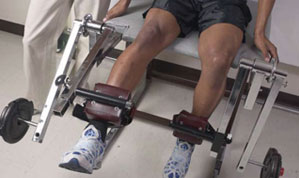 If you are like 22 million other Americans, you have degenerative knee arthritis, a.k.a. osteoarthritis or DJD. This is characterized by cartilage loss, bony overgrowth and extra joint fluid. Symptoms include pain, inflammation, stiffness and swelling. If you have osteoarthritis, it is likely that these symptoms are affecting your lifestyle. There is a wide range of surgical options available for you to achieve relief. The increased incidence of knee cartilage injury in our Baby Boomer population means that more individuals are requiring procedures for joint repair or regeneration of damaged tissue. The goal is to delay or eliminate the need for a total knee replacement by using both biologic and non-biologic methods. These procedures include:
If you are like 22 million other Americans, you have degenerative knee arthritis, a.k.a. osteoarthritis or DJD. This is characterized by cartilage loss, bony overgrowth and extra joint fluid. Symptoms include pain, inflammation, stiffness and swelling. If you have osteoarthritis, it is likely that these symptoms are affecting your lifestyle. There is a wide range of surgical options available for you to achieve relief. The increased incidence of knee cartilage injury in our Baby Boomer population means that more individuals are requiring procedures for joint repair or regeneration of damaged tissue. The goal is to delay or eliminate the need for a total knee replacement by using both biologic and non-biologic methods. These procedures include:
- Arthroscopy, Meniscectomy, Chondroplasty, or Debridement: Damage to the articular cartilage or meniscus can cause pain in your knee. Loose pieces of cartilage can catch in the knee and even cause locking. Through arthroscopy the damaged tissue can be removed or sometimes repaired, while loose fragments can be washed out. Surgeons try to preserve as much of the normal tissue as possible in an attempt to maintain near normal knee mechanics. Recent studies suggest that arthroscopy is minimally effective when arthritis is severe, so another method for repair or regeneration should be considered.
- Osteotomy: If the arthritis or degenerative changes are located in the inner (medial) or outer (lateral) compartment of the knee, your surgeon may recommend changing the alignment of the knee, so that there is less weight placed on the damaged portion. The desired result is less pain. This is recommended for people under the age of 65. The end of the femur (thigh bone) or the tibia (shin bone) must be cut to change the weight-bearing alignment. The bone must heal from this procedure. Healing proceeds better in younger individuals.
- Restoration or Regeneration: Advanced surgical techniques have been developed and employed worldwide to restore the articular cartilage surface. The goal is to biologically restore or regenerate the surface of the joint and to decrease the pain associated with the damage. The development of these procedures has generated a virtually new orthopaedic specialty concerned specifically with the repair or restoration of the joint surfaces.
- Microfracture: The first and least complex is the generation of new cartilage by making small holes in the bone underlying the damaged cartilage. A small blood clot formed in this area as a result of bleeding from the bone and the stem cells in this clot gradually transform into cartilage-producing cells. As the new cartilage matures and fills in the defect, pain is reduced. This procedure works well in people under 30 years of age, with small areas of damage.
- Autologous Chondrocyte Implantation/ACI: This is a relatively complex procedure that involves al least two surgeries. A small segment of cartilage is taken from your knee by arthroscopy during the first procedure. The cartilage is then sent to Genzyme Biosurgery, where it is processed and cultured. In the second surgery (done at least 6 weeks later, the damaged cartilage is removed and a small patch of periosteum (the lining of the bone) is sewn over the defect. The processed cartilage cells are then injected underneath the patch. The cells seed the area and grow new cartilage. Walking is limited for several weeks following this procedure.
- Synthetic Implants/Scaffolding: Newer synthetic materials have been developed to replace the damaged cartilage in discrete areas. These synthetic materials are custom fitted to fill in the holed in the area of defective cartilage. The materials are usually made of calcium derivatives or impregnated bone growth factors. Re-growth of cartilage has been noted with this procedure. However, this procedure is recommended in younger patients, because their blood supply is more substantial. The next step in the evolution of this procedure will be to impregnate the materials with live autologous cartilage cells. Advancement will facilitate more successful cartilage re-growth.
- Joint Resurfacing: As an additional measure to combat the pain form DJD, several new non-biologic procedures for resurfacing the damaged cartilage in specific discrete areas of the knee are being used. Biologic procedures only work if the blood supply is adequate to support healing. These procedures are used when healing is not expected. In one procedure, a custom fitted joint spacer is placed between the tibia and femur in the area of the damaged cartilage. It provides a weight-bearing buffer that relieves pain; older versions of these were used widely in the 1990’s with variable results. The newer version is manufactured to fit each individual by using a specialized magnetic resonance imaging (MRI). Preliminary results have been promising. As an alternative, other implants have been developed to fit the exact curvature of the ends of the femur (condyles) and the back of the patella (kneecap). These are placed into the knee after removal of a thin layer of bone, replacing both the eroded/damaged cartilage and bone. These newer implants are normally used if there are very discrete areas of cartilage damage.
